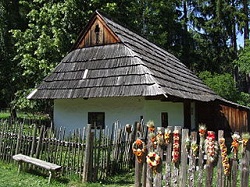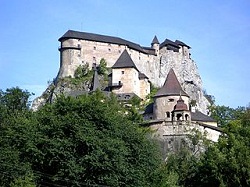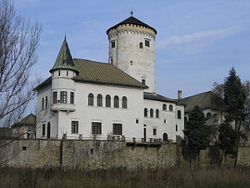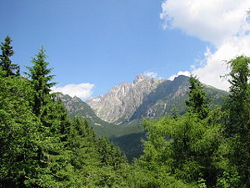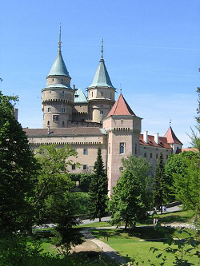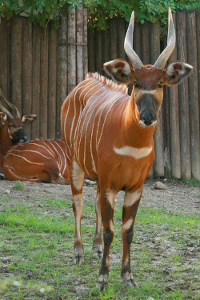SES 2013
Partopreno
Praktikaj
Organizantoj
Ekskursoj
Duontagaj ekskursoj
D: Subĉiela muzeo kaj la urbo Martin
(prezo: 7 EUR, dato: 2013-07-13)
La ekskurso celos konatigi vin kun la urbo Martin (kie SES okazos) kaj kun la historio de Slovakio.
Ni vizitos belegan subĉielan muzeon de slovaka vilaĝo, kiu estas la plej granda nacipriskriba ekspozicio en naturo en Slovakio. Ĝi montras bildon de tradicia popola konstrumetio, loĝado kaj vivmaniero de la loĝantoj de nordokcidenta Slovakio en la 19-a kaj unua duono de la 20-a jarcento. Sur la areo de 15,5 hektaroj troviĝas 143 objektoj (konstruaĵoj), el kiuj 22 viziteblaj ankaŭ de ene.
Pli da informoj ĉe la oficiala retejo...
La urbo Martin (ĝis la jaro 1950 nomata Turčiansky Svätý Martin) estas distrikta urbo kun 60.000 loĝantoj situanta en la regiono Žilina en la distrikto Martin en nordokcidento de Slovakio.
La unua skriba mencio devenis el 1264. La originala urbonomo kreiĝis laŭ la departemento kaj la patrono de la preĝejo. La komunumo urbiĝis en 1340. En 1861 okazis ĉi tie granda kunveno de slovakoj, kie ili postulis aŭtonomion ene de Hungario. La urbo havas grandan signifon por moderna historio de Slovakio. Ĉi tie funkciis unu el la unuaj tri slovakaj gimnazioj. Siajn sidejon ĉi tie havas la kultura institucio Matica slovenská kaj la Slovakia nacia biblioteko, kaj troviĝas ĉi tie ankaŭ Nacia tombejo. Promenante tra la urbocentro ni vizitos ankaŭ la Muzeon de Martin Benka – nacia pentristo, kiu aldone estis tre aktiva esperantisto – kaj eblos vidi ankaŭ liajn Esperantajn desegnaĵojn.
Pli da informoj en Vikipedio...
E: Oravia burgo kaj oravia arbara trajnvojaĝo (per historia vaportrajno)
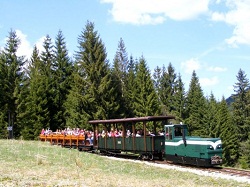
La arbara fervojeto
(prezo: 18 EUR, dato: 2013-07-14)
La fervojon konstruigis la nobelula Oravia Kunposedantaro. La ĉefa vojlinio estis 22,6 km longa, kondukis el Lokca ĝis la municipo Erdútka (hodiaŭ nomata Oravská Lesná). En 1971 ĝi estis oficiale nuligita, ekde la 80-aj jaroj tamen okazas aktivaĵoj cele al ĝia renovigo. Parto de la vojo estas hodiaŭ jam rekonstruita.
Ĉar temas pri belvida vojaĝo, la vagonoj havas malfermitan konstruon kaj moviĝas malrapide (20 km/h). Oni veturas kaj tra kampoj, kaj tra densa arbaro kie tre ofte videblas la arbaraj bestoj. La trajno veturas al la stacio Sedlo Beskyd, en distanco de proksimume 3,5 km. Tie eblas supreniri turon, el kiu estas belega elvido al la ĉirkaŭa naturo. La trajneto atendas 15–20 minutojn kaj poste ekveturas reen en la valon. La tuta programo daŭras unu horon. En la vala stacio oni povas trarigardi muzean ekspozicion, aĉeti memoraĵojn aŭ viziti kun siaj infanoj ludejon.
Pli da fotoj ĉe la oficiala retejo...
La Oravia burgo estas unu el la plej belaj burgoj en Slovakio, situanta en la municipo Oravský Podzámok. Ĝi estas nacia kultura heredaĵo kaj dominanto de ta tuta regiono Oravio. La unua skribmencio devenas de la jaro 1267, kiam la burgon akiris hungaria reĝo Belo la 4-a. Dum pliaj 300 jaroj ĝi restis reĝa fortikaĵo.
La ejoj retrovis praktikan uzon en 1868, kiam en la burga areo estis fondita Muzeo de la Oravia Kunposedantaro. Tiu muzeo do apartenas inter la plej malnovajn muzeojn en Slovakio. Ekspozicioj orientiĝas al loĝkutimoj de la mez- kaj novepoko, historio de armea tekniko kaj al arto de la unuopaj jarcentoj. La plej bela ĉambro, Kavalira salono, kune kun la burga kapelo estas tre ŝatataj okazejoj de geedziĝaj ceremonioj.
Pli da informoj en Vikipedio...
F: Burgo Strečno, kastelo Budatín, urbo Žilina
(prezo: 18 EUR, dato: 2013-07-18)
Sep kilometrojn for de la urbo Žilina, romantika ruino de la burgo Strečno dominas super la rivero Váh kiel simbolo de iama feŭdala povo en la meza regiono Považie. Kvankam ĝi estas jam ekde tri jarcentoj ruino, daŭre konserviĝis arkitekturo montranta ĝian evoluon ekde gotiko ĝis baroka epoko. Post parta rekonstruo, ekde 1995 la ruino estas alirebla por la publiko. Inter daŭrajn ekspoziciojn en la loko apartenas forĝista metiejo, kie la vizitantoj povas konatiĝi kun specialaj iloj uzataj de forĝisto. La ruino estas administrata de la Považie-muzeo en Žilina. En 1994 oni registris ĉi tie scenojn de la usona filmo Dragonheart (Draka koro).
Žilina estas la kvara plej granda urbo de Slovakio, centro de nordokcidenta Slovakio. Foje ĝi estas kromnomata "Perlo ĉe la rivero Váh". La unuajn urbajn rajtojn ĝi ricevis de la reĝo Andreo la 3-a ĉirkaŭ la jaro 1290. En la urbo vivis slovakoj kaj germanoj. La unua skriba mencio pri urba komunumo devenas de 1312. Gravega kultura memoraĵo estas Žilinská kniha (La Libro de Žilina) enhavanta aron de juraj preskriboj de la germana urbo Magdeburg, kiujn tiam obeis ankaŭ Žilina.
Inter multaj arkitekturaj kaj kultuaj memoraĵoj de Žilina menciindas la kastelo Budatín, ankaŭ kiun ni vizitos. Pasintece ĝi estis burgo kun akvofoso, sed poste oni rekonstruis ĝin al kastelo. En ĝi hodiaŭ havas sian sidejon la Považie-muzeo. Viziteblas i.a. dratumista ekspozicio, kaj tra la kastela parko gvidas instrua pado kun klarigoj pri multaj naturaj interesaĵoj. Al la kastelo rilatas la multfoje literature prilaborita legendo pri filino de la kastelestro. Laŭdire la patro enmurigis ŝin en kastelan turon, ĉar ŝi rifuzis edziniĝi al viro, kiun la patro elektis por ŝi.
Pli da informoj en Vikipedio...
Tuttagaj ekskursoj
Rimarko: Vi povas elekti maksimume unu el la tuttagaj ekskursoj, ĉar ambaŭ okazos dum la sama tago (marde, 2013-07-16).
A: Altaj Tatroj
(prezo: 27 EUR, dato: 2013-07-16)
Altaj Tatroj (slovake Vysoké Tatry, pole Tatry Wysokie) estas la plej alta montaro en Slovakio kaj en Pollando. Tatra nacia parko (slovake Tatranský národný park - TANAP) troviĝas en la nordokcidenta parto de orienta Slovakio ĉe la ŝtata limo kun Pollando. Samtempe ĝi estas la plej malgranda montarego en la mondo, ĉar ĝi okupas nur 260 km². Ĝi estis formiĝinta de ekstrema altaĵa reliefo kiel rezulto de glacia aktiveco. El la vidpunkto de turismo en Slovakio ĝi estas la plej grava montaro. La setlejo Štrbské Pleso ĉe la lago Štrbské pleso fariĝis grava sporta centro, kie troviĝas ordigitaj spurejoj por skituristoj kaj ski-saltsportistaj pontoj. Ekde 1993 Tatra nacia parko (kune kun sia pola parto) apartenas al unu el kvar biosferaj protektitaj areoj de la programo UNESCO Homo kaj biosfero (Man and Biosphere - MaB).
La ekskurso estos relative facila, sen tro komplika montgrimpado, kun belega panoramo al apudaj montoj. Tamen ni rekomendas pretigi komfortajn ŝuojn kaj esti preta marŝi ĉ. 10-13km. La itinero iros de la lago "Štrbské pleso" al la lago "Popradské pleso", kun halto en la simbola tombejo (memore al la turistoj, kiuj pereis en la Tatroj).
Štrbské pleso [Ŝtrbske pleso] estas bela monta lago de glacia origino en la Altaj Tatroj en la setlejo Štrbské Pleso en Slovakio. Štrbské pleso estas glacio-kovrita dum ĉirkaŭ 155 tagoj dum jaro. Estas kelkaj hoteloj konstruitaj ĉirkaŭ la lago kaj turismaj vendejoj apude.
Pli da informoj en Vikipedio...
B: Bojnice – urbo, kastelo, bestoĝardeno
(prezo: 27 EUR, dato: 2013-07-16)
Bojnice estas ban-urbo situanta en meza Slovakio. La varmajn akvofontojn mencias jam dokumentoj el la 13-a jarcento. En 1938 la banlokon aĉetis la mondkonata firmao Baťa, poste ĝi apartenis al la ŝtato kaj ekde 1995 ĝi estas akcia kompanio.
Historio de la banloko nedisigeble kuniĝas kun la kastelo Bojnice. Temas pri romantika kastelo, kun parte origina gotika kaj renesanca bazo. La kastelo aperas en multaj filmoj kaj ĉiujare okazas en ĝi la konata Festivalo de spiritoj kaj monstroj, ege populara ĉe infanoj. Nuntempe ĝi estas administrata de la Slovakia nacia muzeo. Sub la kastelo estis ankaŭ malkovrita kaverno kaj en apuda granda parko kreskas la plej malnova arbo en Slovakio, proksimume 700-jara tilio.
Dum la ekskurso ni vizitos ankaŭ la faman bestoĝardenon. Lastatempe ĝi strebas orientiĝi al raraj kaj endanĝerigitaj bestospecioj – interalie la cerkopitekeno Roloway (speco de simio) kaj la antilopo Bongo.




